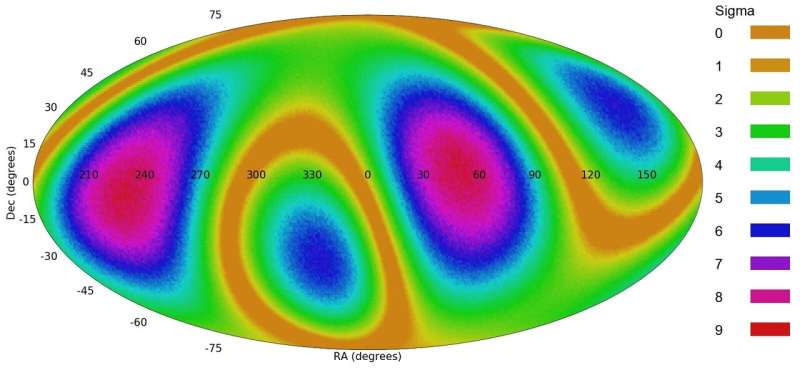Write4U
Valued Senior Member
Patterns in the Universe
Study finds that patterns formed by spiral galaxies show that the universe may have a defined structure
by Kansas State University

An all-sky mollweide map of the quadrupole in the distribution of galaxy spin directions. In this image, the different colors mean different statistical strength of having a cosmological quadrupole at different points in the sky. Credit: Kansas State University
IMO, most of what we know of the universe is revealed by the existing patterns which suggest how the universe evolved in particular patterns and allow us to calculate possible futures based on the patterns observable today.
To me, this all suggests an influential mathematical aspect to the universe, and is why I follow Tegmark in his quest to find the TOE (if it can be found), which has to be able to be expressed in mathematical terms.
Study finds that patterns formed by spiral galaxies show that the universe may have a defined structure
by Kansas State University

An all-sky mollweide map of the quadrupole in the distribution of galaxy spin directions. In this image, the different colors mean different statistical strength of having a cosmological quadrupole at different points in the sky. Credit: Kansas State University
An analysis of more than 200,000 spiral galaxies has revealed unexpected links between spin directions of galaxies, and the structure formed by these links might suggest that the early universe could have been spinning, according to a Kansas State University study.
https://phys.org/news/2020-06-patterns-spiral-galaxies-universe.htmlLior Shamir, a K-State computational astronomer and computer scientist, presented the findings at the 236th American Astronomical Society meeting in June 2020. The findings are significant because the observations conflict with some previous assumptions about the large-scale structure of the universe..... more
IMO, most of what we know of the universe is revealed by the existing patterns which suggest how the universe evolved in particular patterns and allow us to calculate possible futures based on the patterns observable today.
To me, this all suggests an influential mathematical aspect to the universe, and is why I follow Tegmark in his quest to find the TOE (if it can be found), which has to be able to be expressed in mathematical terms.
Last edited:


